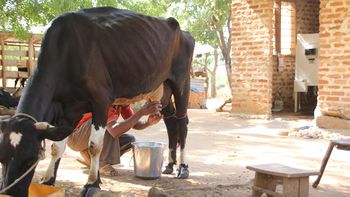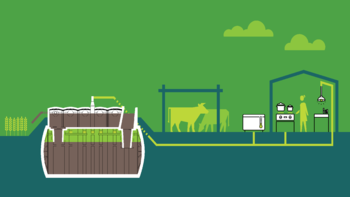Biogas Milk Chilling to Increase Productivity and Incomes of Dairy Farmers
Overview
|
Innovator |
||
|
Project |
Biogas Milk Chilling to Increase Productivity and Incomes of Dairy Farmers | |
|
Collaborators |
||
|
Location Applied |
The emerging dairy industry in East Africa affects the livelihoods of more than 2 million smallholder farmers. While demand is expected to more than double in coming years, only 15 percent of milk produced reaches the formal market and 30–50 percent is not delivered to milk collection centers. The reason being that raw milk is not cooled at farm level because 85 percent of rural East Africa lacks access to a (reliable) power grid. There are no solutions available on the market to provide milk chilling at micro-scale, for farmers with up to 10 dairy cows, that run independently from the power grid, and that comply with the International milk coolingstandard. This creates a huge opportunity to close the supply-demand gap.[1]
Clean Energy Solution
SimGas is developing the first off-grid, biogas-powered milk chiller at farm level to help milk supply meet demand: the SimGas Biogas Milk Chiller (BMC). The BMC sparks a revolution in the dairy industry; it is the first link towards a reliable milk cool chain from cow to dairy. It helps small dairy farmers to reduce milk losses and meet quality standards required to access the formal sector. The BMC runs on biogas, produced with an on-farm biogas digester. The amount of manure produced by a cow creates enough biogas to refrigerate her own milk, while leaving enough biogas to cook a meal for the household.[1]
Impact
The SimGas Biogas Milk Chiller will empower small dairy farmers to guide their own development; the BMC can greatly improve the income of small dairy farmers, help supply to meet demand, help farmers to access the formal dairy market, and contribute to improved nutrition. The quantity and quality of milk will improve, which will enable dairies to better meet the increasing demand for milk and milk products. Savings at the farm level will lead to additional investments and more satisfied members. In addition, the use of clean energy (biogas) for cooling and other purposes, such as cooking, will help reduce deforestation and carbon emissions.[1]
Organization
SimGas is a design and production company with facilities in the Netherlands and East Africa that focuses on clean, affordable, and high quality energy and sanitation solutions. Their teams work together to design, manufacture, and install high quality, modular, domestic biogas systems that can be installed in a day. By doing so, SimGas creates healthy and safe environments for millions of rural households while contributing to the reduction of indoor air pollution, deforestation, and carbon emissions. Together with partner SNV—world leader in promoting domestic biogas in developing countries with 25 years of experience in the sector—SimGas is developing and will demonstrate off-grid, small-scale, biogas-powered milk chillers for smallholder farmers in Kenya, Tanzania and Rwanda.[1]
Progress Update
SimGas is currently focused on work in Kenya, with plans to begin operations in Rwanda in FY2018. They have 10 pilot installations in Kenya and Tanzania. SimGas has been conducting lab and field testing on several different models of milk chillers. Recent human centered design research conducted together with IDEO.org was used to modify the milk chiller design, resulting in reduced gas consumption, which allows for extended biogas availability for cooking in addition to cooling. They are currently testing 3 units of this latest prototype design at model farmers of Kenya’s largest dairy processor. SimGas expects to begin mass production of the biogas milk chiller in the coming year.[1]
Further Information
- Powering Agriculture Portal on energypedia
- Powering Agriculture Homepage, Winners/ Innovators
- Powering Agriculture: An Energy Grand Challenge for Development
- Powering Agriculture Newsletters
- Kenya Energy Situation
- Rwanda Energy Situation
- Tanzania Energy Situation
- Website SimGas Tanzania, Ltd.
- Website SNV (Netherlands)






















